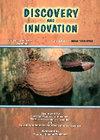Speciation of Zinc mixed ligand complexes in salt water systems
引用次数: 0
Abstract
Amalgam voltammetric method has been used to study heavy metal interaction in model lake water in KNO3 at 23¼C at concentration levels of genuine lake water of total ionic strength 1.44 M. Hanging drop amalgam electrode was prepared in situ before exchanging the medium containing Zn2+ ions for the sample solution with ligands of known concentrations. Half-wave potentials at the actual metal ion concentration in the lake and at a much lower one (10-2 times) were experimentally determined. Shifts in half-wave potentials are used to compute metal complex formation constants. The study reveals the existence of various species and a prediction is made of the distribution of the major labile complex species of Zn2+ present in the lake water. The concentration level of Zn2+ ions in the lake seems to play a role in determining the number of complexes formed and their stabilities. The results show that hydroxo/chloro and hydroxo/fluoro mixed ligand complexes have free Zn2+ ions as predominant species at the natural pH of the lake water and these systems are, therefore, potentially polluting. However, the contribution of OH- ions to the speciation of Zn is of no consequential effect because in its normal state, the [OH-] of the lake water is quite low and the aquatic life is, therefore, not threatened. The CO3 2- ions are the major contributors to the speciation of zinc in the lake water because the natural [CO3 2-] of 0.5 M is high. The normal lake water is thus, dominated by the carbonato complexes [ZnCO3Cl4]4-, [ZnCO3Cl2]2-, [ZnCO3Cl]- and to a less extent, ZnCO3. Keywords : Heavy metals, hanging drop electrode, amalgam voltammetry, speciation. Discovery and Innovation Vol. 19 (3) 2007: pp. 188-194锌混合配体配合物在盐水体系中的形态
采用银汞伏安法,在离子总强度为1.44 m的真实湖水浓度水平下,用23¼C的KNO3模拟湖水中重金属的相互作用进行了研究。在用已知浓度的配体交换含有Zn2+离子的介质之前,原位制备挂滴银汞电极。实验测定了湖泊中实际金属离子浓度和较低金属离子浓度(10-2倍)时的半波电位。利用半波电位的位移计算金属络合物形成常数。研究表明,湖水中存在多种Zn2+,并对湖水中Zn2+主要不稳定络合物的分布进行了预测。湖泊中Zn2+离子的浓度水平似乎决定了络合物形成的数量及其稳定性。结果表明,在湖水的自然pH值下,羟基/氯和羟基/氟混合配体配合物以游离Zn2+离子为主,具有潜在的污染作用。然而,OH-离子对Zn形态的贡献并不会产生相应的影响,因为在正常状态下,湖水中的[OH-]含量很低,因此不会对水生生物造成威胁。由于0.5 M的天然[co32 -]较高,co32 -离子是湖泊水体中锌形态的主要贡献者。因此,正常的湖水以碳酸配合物[ZnCO3Cl4]4-、[ZnCO3Cl2]2-、[ZnCO3Cl]-和少量的ZnCO3为主。关键词:重金属,垂滴电极,银汞伏安法,形态。科学发现与创新Vol. 19 (3) 2007: pp. 188-194
本文章由计算机程序翻译,如有差异,请以英文原文为准。
求助全文
约1分钟内获得全文
求助全文

 求助内容:
求助内容: 应助结果提醒方式:
应助结果提醒方式:


